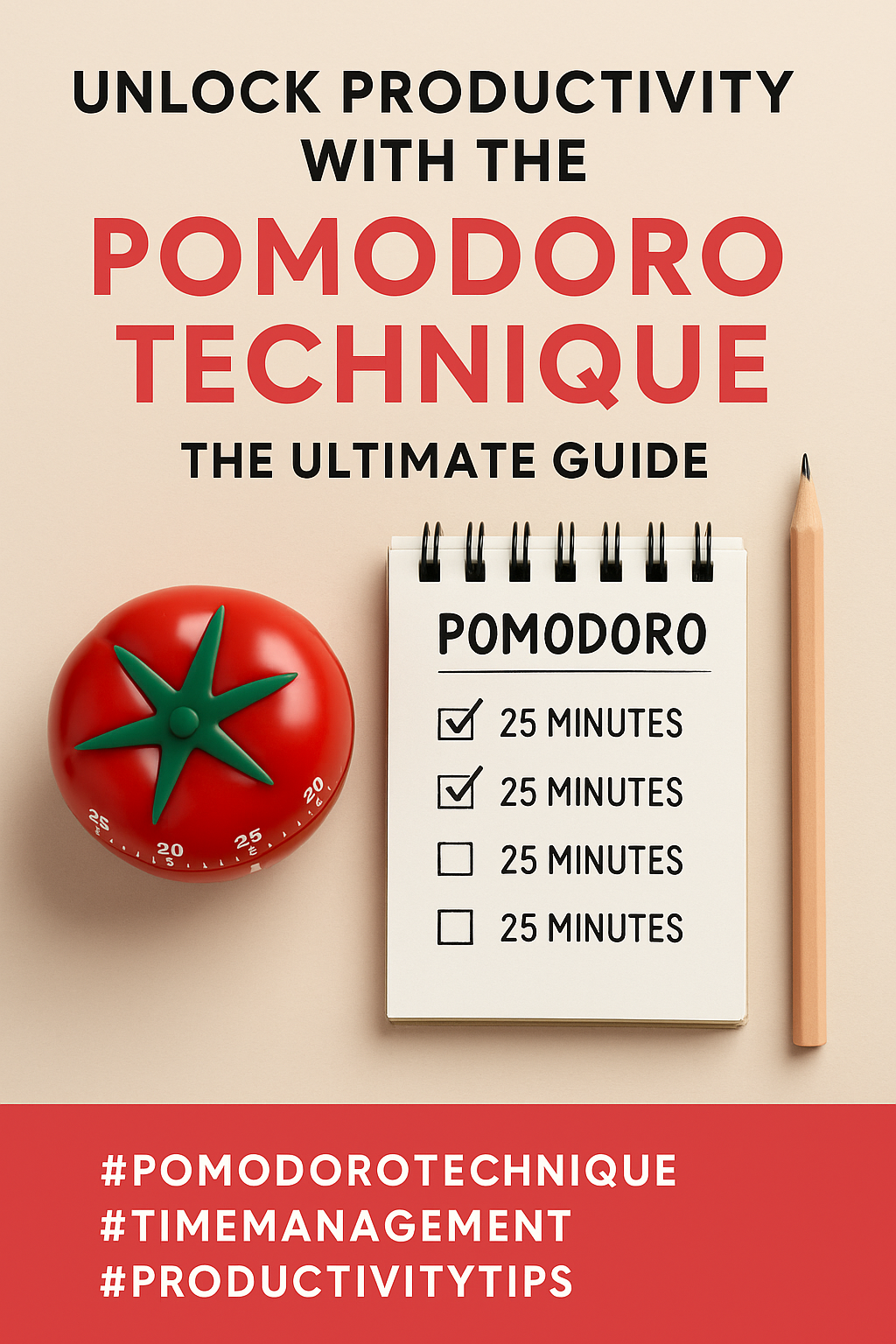Overview of the Pomodoro Technique
The Pomodoro Technique is a time management method designed to boost productivity by breaking work into manageable intervals, traditionally 25 minutes long, separated by short breaks. This technique not only helps individuals stay focused but also encourages a work-life balance by incorporating regular pauses. The beauty of this approach lies in its simplicity and effectiveness, making it suitable for anyone seeking to enhance their efficiency, whether a student, a professional, or a creative individual.
What is the Pomodoro Technique?

At its core, the Pomodoro Technique is about maximizing focus and minimizing distractions. The concept revolves around the idea that the timer creates a sense of urgency, which encourages people to work harder and more efficiently. After every work session, short breaks serve as a reward and a chance to recharge, enhancing overall productivity and mental clarity.
History and Origin
The Pomodoro Technique was developed by Francesco Cirillo in the late 1980s. Cirillo named the technique after the Italian word for tomato, pomodoro, after the tomato-shaped kitchen timer he used as a university student. Over the years, this deceptively simple method has gained popularity, with countless individuals and organizations adopting it to improve workflow and efficiency.
How It Works
The Pomodoro Technique operates on a straightforward principle: work in focused bursts followed by breaks. Each session, or Pomodoro, lasts for 25 minutes, and once completed, it is followed by a 5-minute break. After completing four Pomodoros, a longer break of 15 to 30 minutes is taken. This structure not only helps maintain high levels of focus but also combats fatigue and enhances motivation.
Everyone needs Tools Like This!
Benefits of Time Management
Time management is crucial for personal and professional success. By organizing tasks effectively, individuals can achieve more in less time, leading to lower stress levels and improved mental well-being. The Pomodoro Technique is particularly effective in this regard, as it promotes structured work habits and encourages a disciplined approach to task completion.
Enhancing Focus and Concentration
One of the primary benefits of the Pomodoro Technique is its ability to enhance focus and concentration. The method encourages users to dedicate their attention solely to a specific task for a defined time, which can significantly reduce the likelihood of distractions. By honing in on a single activity, individuals can produce higher quality work within a shorter time frame.
Breaking Down Tasks

The Pomodoro Technique allows for the breakdown of larger tasks into smaller, more manageable chunks. This division makes daunting projects feel more achievable, as individuals can focus on completing one segment at a time. This method not only aids in clarity but also provides a satisfying sense of accomplishment with each completed Pomodoro.
Reducing Burnout
By incorporating regular breaks into the workflow, the Pomodoro Technique helps reduce the risk of burnout. Continuous work without rest can lead to mental fatigue and decreased productivity. The scheduled breaks serve as a mental reset, allowing individuals to recharge and return to their tasks with renewed energy and focus.
Steps to Implement the Technique
Implementing the Pomodoro Technique is straightforward and can be tailored to fit individual needs. Here’s a step-by-step guide to help anyone get started with this effective time management strategy.
The first step in using the Pomodoro Technique is to select the task you want to work on. This could be an ongoing project, studying for an exam, or even household chores. It’s crucial to choose a specific activity to maintain focus and avoid multitasking, which can dilute productivity.
Once you have chosen your task, set a timer for 25 minutes. This time frame is essential as it provides a clear boundary for your work session. You can use a traditional kitchen timer, a smartphone app, or a dedicated Pomodoro timer. The key is to ensure the timer is visible and audible, so you remain aware of the time.
During the 25-minute work session, focus solely on the task at hand. Avoid any distractions, such as checking your phone or browsing the internet. If any distracting thoughts arise, jot them down on a notepad to address later, ensuring you remain fully engaged in your work.
Once the timer rings, take a 5-minute break. This is your time to step away from your workspace, stretch, move around, or grab a drink. The purpose of this break is to give your mind a chance to relax and recharge, enhancing your overall productivity for the next work session.
After completing four Pomodoros (four 25-minute work sessions), take a longer break of 15 to 30 minutes. This extended break is crucial for recharging your mental batteries and preparing you for the next round of focused work. Repeat the cycle as needed, adjusting the number of Pomodoros and breaks according to your personal preferences and workload.
Overcoming Distractions
Distractions are one of the most significant barriers to productivity. Whether they are internal thoughts or external interruptions, managing distractions is crucial for the successful implementation of the Pomodoro Technique. Understanding your distractions and finding ways to mitigate them can lead to a more productive work environment.
Identifying Your Distractions
Start by identifying what typically distracts you during work sessions. Common distractions may include phone notifications, social media, noisy environments, or even other people. Keeping a distraction journal can help you pinpoint patterns and determine what interrupts your flow most frequently.
Strategies to Minimize Interruptions
Once you’ve identified your distractions, it’s time to implement strategies to minimize them. For digital distractions, consider using apps that block notifications during work sessions. For environmental distractions, create a dedicated workspace that is quiet and free from interruptions. Communicate your working hours to those around you to establish boundaries and minimize disruptions.
Creating a Productive Environment
A productive environment plays a vital role in the success of the Pomodoro Technique. Ensure your workspace is organized, comfortable, and conducive to concentration. Personalize your area with elements that inspire you, like plants or motivational quotes, while keeping it clutter-free to reduce visual distractions.
Tools and Apps to Use
The right tools can enhance the effectiveness of the Pomodoro Technique. Whether you prefer digital solutions or traditional methods, numerous options exist to suit your preferences and lifestyle.
Popular Pomodoro Timer Apps
There are several apps specifically designed for the Pomodoro Technique. Popular options include Focus Keeper, Pomodoro Tracker, and Be Focused. These apps not only keep track of your work sessions and breaks but often come with additional features such as analytics to help you monitor your productivity trends over time.
Using Traditional Timers
If you prefer a simpler approach, a traditional kitchen timer can be just as effective. The tactile experience of setting a physical timer may enhance your commitment to the task. Plus, it’s a distraction-free tool that doesn’t rely on technology, allowing for a more focused work session.
Integrating with Task Management Tools
Integrating the Pomodoro Technique with task management tools like Trello, Asana, or Todoist can streamline your workflow even further. These platforms allow you to organize your tasks visually while incorporating the Pomodoro Technique to maintain focus and structure. By combining traditional task management with timed sessions, you’ll create a robust productivity system tailored to your needs.
Need help building your productivity toolkit?
Conclusion and FAQs
The Pomodoro Technique is a powerful tool for enhancing productivity, focus, and time management. By breaking work into manageable intervals and incorporating regular breaks, individuals can effectively combat distractions and reduce burnout. Remember, the key to success with this technique is consistency and adaptability. As you experiment with your Pomodoro sessions, feel free to modify the timing and breaks to find what works best for you.
Traditionally, a Pomodoro session lasts for 25 minutes, followed by a 5-minute break. However, you can adjust these times to better suit your focus levels and the nature of your tasks.
Yes, the Pomodoro Technique can be applied to various types of work, including studying, writing, coding, and even household chores. It’s versatile enough to enhance productivity across different tasks.
If you experience interruptions during a Pomodoro session, try to minimize them by communicating your focus time to others. If it’s unavoidable, pause your timer and resume after addressing the interruption. Jot down any distracting thoughts to return to later without losing focus.
To improve concentration, start by creating a distraction-free environment and regularly practicing focused work sessions. As you become accustomed to the technique, you’ll likely find it easier to concentrate for longer periods.
Yes, while the Pomodoro Technique is often used for individual tasks, it can be adapted for team settings. Teams can synchronize their Pomodoro sessions and breaks to enhance collaboration and productivity during group projects.
In summary, the Pomodoro Technique offers a simple yet effective way to enhance productivity and manage time efficiently. By understanding its principles and leveraging the right tools, anyone can maximize their focus and achieve their goals.








2 thoughts on “Master Time Management”
Hello, i feel that i noticed you visited my blog so i came to go back the want?.I’m attempting
to to find issues to improve my site!I guess its ok to use a few of your ideas!!
Heya i am for the first time here. I found this board and I find It really
useful & it helped me out a lot. I hope to give something back and help others like
you aided me.